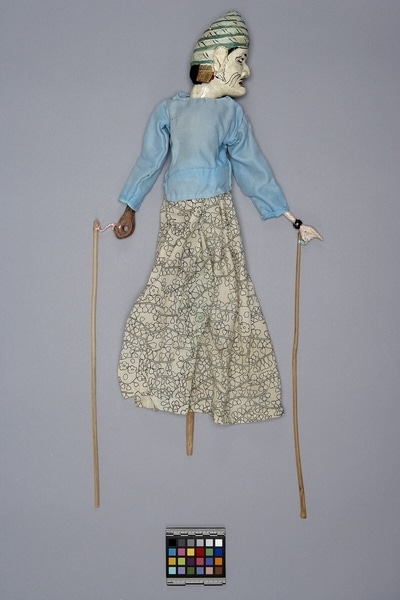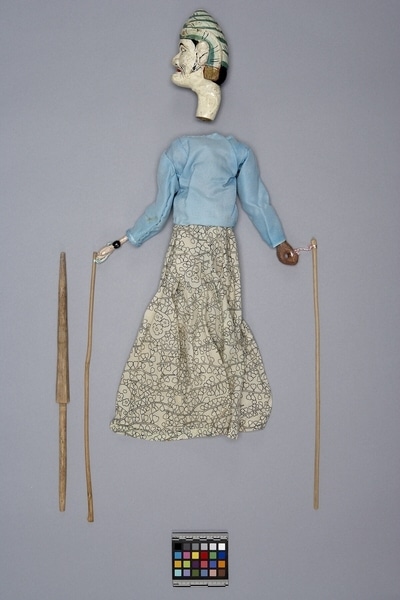Rod Puppet Item Number: Ib279 a-c from the MOA: University of British Columbia


Description
Indonesian hand puppet; carved upper body (part a), extending to a wooden handle. Forward extending head (part b) with white face and upturned red eyes; mouth cast in a dissatisfied expression. Black highlighted facial features, hints of chin , beard, and sideburns. Head wrapped with a spiraling wound turban -songkok- of alternating dark and light green with gold tassels. Jointed arm on the right painted pink and is narrow, thicker arm to the left is unpainted. Both arms attached to supporting sticks with string. Figure wears a soiled light blue blouse overlying a red and white checkered body covering. Waist and legs wrapped in a skirt printed with a pattern of black and cream. Both blouse and skirt are made of synthetic material. Paint slightly chipped and peeling on turban. Pointed single controlling rod (part c).
History Of Use
Javanese puppetry as an art form probably developed by the 11th century. The three-dimensional wooden wayang golek puppets of western Java, which are to be distinguished from the earlier and more sacred wayang kulit shadow plays puppets or other forms, appeared during the 16th century. Originally the plays depicted Javanese mythology, but after the Indian conquest of Java the Hindu epics, Ramayana and Mahabharata, were incorporated into the cycles, which comprise about 200 plays. An individual or group hires a dalang (puppet-master) to celebrate important occasions. The performances often last all night and are generally presented in three acts, with vocal and instrumental accompaniment. The individual plays vary widely in detail but usually involve conflict between good and evil. They serve a moral and religious purpose, and more recently, one of political commentary. Each puppet's character is represented by its appearance and placement onstage; protagonists with strong elements of good are placed to the right, antagonists of violent or evil nature to the left. In each set of puppets there are usually at least two pandita puppets. They serve the purpose of demonstrating the nature of mixed characters who are not inspired to action purely by evil or noble motives. They can appear in the retinues of either side of the inevitable conflicts of the various cycles.
Iconographic Meaning
Puppet represents a pandita, literally a holy teacher or seer. White face indicative of youth, innocence, or righteousness. A forward extending head generally associated with divine nature; also wears a turban or songkok worn by deities or priests. However, its red upturned eyes are an ambiguity, symbolizing opposition to cosmic order. Possession of two differing arms is typical of puppets with contrasting traits of good and evil; thus, there is often no decisive division between the protagonists and antagonists.
Cultural Context
Theatrical performance.
Item History
- Made in Java, Indonesia
- Owned by Tradewind Antiques before March 15, 1983
- Received from Museum of Anthropology Shop Volunteers (Funding source) and Tradewind Antiques (Seller) on March 15, 1983
What
- Name
- Rod Puppet
- Identification Number
- Ib279 a-c
- Type of Item
- puppet
- Material
- wood, synthetic fibre, paint and fibre
- Manufacturing Technique
- carved, painted, machine woven and sewn
- Part A
- height 61.0 cm, width 20.0 cm, depth 6.4 cm
- Part B
- height 16.7 cm, width 6.2 cm, depth 9.5 cm
- Part C
- height 37.3 cm, width 1.7 cm, depth 1.2 cm
Who
- Culture
- Sundanese
- Previous Owner
- Tradewind Antiques
- Received from
- Museum of Anthropology Shop Volunteers (Funding source) and Tradewind Antiques (Seller)
Where
- Holding Institution
- MOA: University of British Columbia
- Made in
- Java, Indonesia
When
- Ownership Date
- before March 15, 1983
- Acquisition Date
- on March 15, 1983
Other
- Condition
- good
- Accession Number
- 0886/0013 a-c